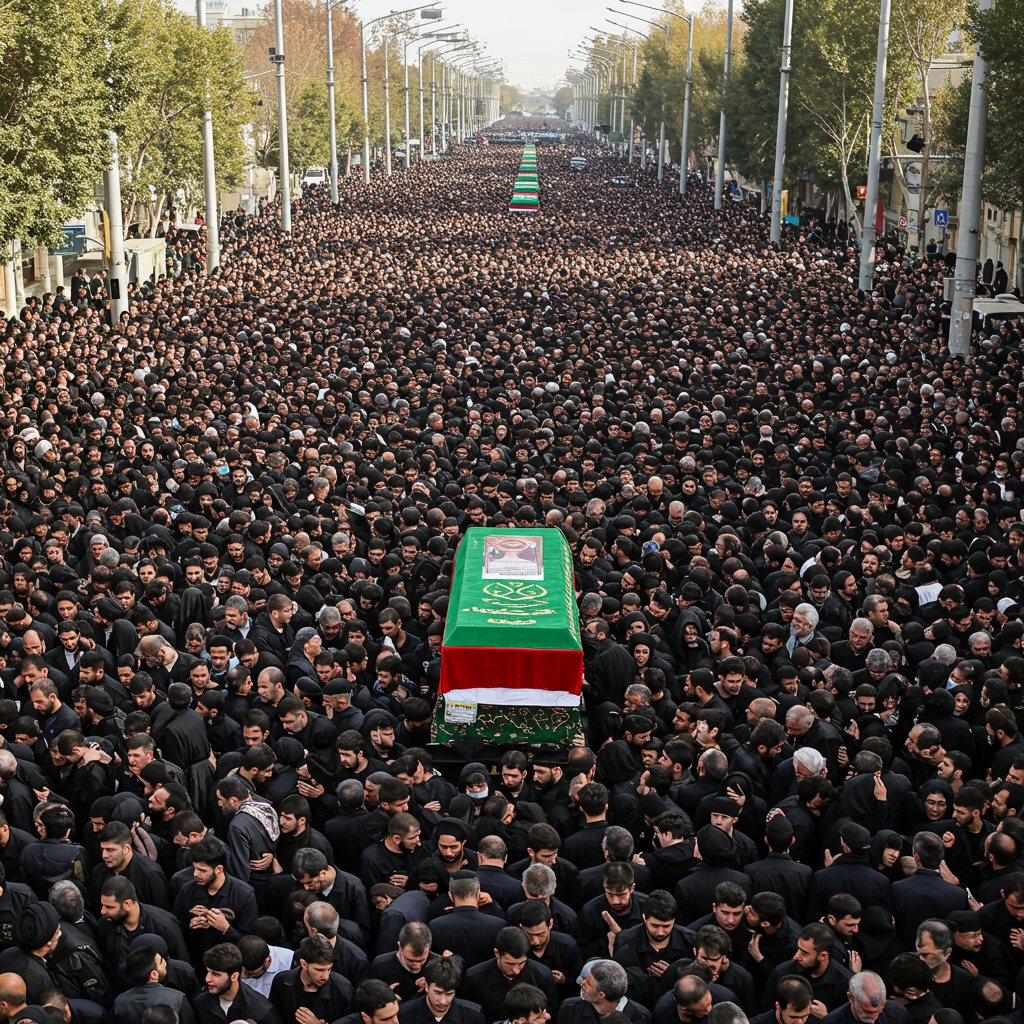Tehran witnessed an immense outpouring of grief on Saturday, June 28, 2025. Hundreds of thousands of mourners lined the streets. They gathered for the state funeral of top military commanders and nuclear scientists. These individuals were killed during a recent, intense 12-day conflict with israel. The event served as a powerful public demonstration of national mourning and defiance following significant casualties. The Associated Press classified the confrontation as a “war.”
Honoring Fallen Figures in Tehran
The funeral procession unfolded across the heart of Tehran. Mourners filled major thoroughfares like Azadi Street. Estimates by state media suggested over a million attendees. Independent verification of this number proved difficult. However, the dense crowd visibly packed the entire 4.5-kilometer (nearly 3-mile) route. Flag-draped caskets were transported on trucks. They belonged to some of Iran’s most prominent figures. These included the head of the Revolutionary Guard, Gen. Hossein Salami, and the head of the Guard’s ballistic missile program, Gen. Amir Ali Hajizadeh. Both generals reportedly died on June 13. This was the first day of Israel’s military campaign. People in the crowd chanted potent slogans. These included “Death to America” and “Death to Israel.” Photos from the event showed Israeli and American flags being stepped on or burned. Ballistic missiles were also displayed.
The ceremonies paid tribute to a total of 60 people. This figure included 16 scientists and 10 senior commanders. Tragically, four women and four children were also among the deceased honored. The funerals were the first public services for top commanders held since a ceasefire took effect on Tuesday, June 24. Government offices were closed across the country. This allowed public servants to attend the mass mourning event.
Notable Attendees and Surviving Officials
Several high-ranking iranian officials were present. Foreign Minister Abbas Araghchi was on hand. Gen. Esmail Qaani, head of the Quds Force (the Guard’s foreign operations wing), attended. Gen. Ali Shamkhani, an adviser to Supreme Leader Ayatollah Ali Khamenei, was also among the mourners. Iranian President Masoud Pezeshkian participated in the march. Even a son of the Supreme Leader, Mojtaba Khamenei, was reported to be present.
Gen. Ali Shamkhani’s appearance drew particular attention. He was shown in a civilian suit, leaning on a cane. Shamkhani had been wounded in an early Israeli strike on his residence. He was hospitalized following the attack. State television later broadcast an interview with him. Shamkhani recounted waking for dawn prayer when the strike hit. He initially thought an earthquake had occurred. It took search and rescue teams three hours to find him in the rubble. He sustained significant internal injuries, including a chest fracture. Shamkhani stated that he and other generals knew they were potential targets before the conflict began.
The 12-Day Conflict Context
The mass funeral followed a brief but intense 12-day period of hostilities. The conflict began on June 13 with Israeli strikes. Israel stated its objective was to destroy Iran’s nuclear program. It specifically targeted military commanders, scientists, and nuclear facilities. This came after warnings regarding Iran’s nuclear experiments were reportedly ignored. Israel views Iran’s nuclear activities as an existential threat. Iran maintains its nuclear program is solely for peaceful purposes.
Iran retaliated with its own missile attacks against Israel. The United States later joined the conflict. The US conducted strikes on three Iranian nuclear sites. These were Fordow, Isfahan, and Natanz. Iran responded by firing missiles at a US base in Qatar. This tit-for-tat exchange defined the intense fighting.
Conflicting Casualty Reports
Casualty figures from the conflict differed significantly depending on the source. Israel claimed to have killed approximately 30 Iranian commanders. They also reported killing 11 nuclear scientists. Israel stated it hit eight nuclear-related facilities. Over 720 military infrastructure sites were also targeted. Iran’s Ministry of Health, however, reported a higher number of civilian deaths. They stated Israeli attacks killed at least 627 civilians in Iran. A Washington-based Human Rights Activists group estimated the total Iranian death toll exceeded 1,000. This figure included at least 417 civilians.
On the Israeli side, Iran reported firing over 550 ballistic missiles. Most were intercepted, often with US support. However, some missiles did get through. These caused damage in various areas. According to Israeli figures, these attacks resulted in 28 deaths in Israel. Thousands were reported wounded in both countries.
Public Sentiment and Future Uncertainty
The atmosphere among mourners in Tehran was thick with emotion. Anger and defiance were palpable. Many expressed strong nationalist sentiments. Some rejected the notion of a true ceasefire. “This is not a ceasefire,” said one attendee. “This is just a pause.” Waving an Iranian flag, he vowed a “crushing response” to Israel’s actions. This suggests a deep-seated desire for retribution among parts of the population. The state funeral clearly served as a channel for collective grief and political expression.
Burial sites for the deceased varied. Many were to be interred in their hometowns. However, some notable figures were buried in Tehran. Gen. Mohammad Bagheri, the army chief of staff, was killed on the first day of the war. He was laid to rest at Tehran’s Behesht-e-Zahra cemetery. His grave is beside that of his brother, a Guards commander killed in the 1980s Iran-Iraq war. Ali Ghanaatkar, the top prosecutor at the notorious Evin prison, was also killed in an Israeli strike. Known for prosecuting dissidents, he was to be buried at a shrine in Qom.
Post-Ceasefire Rhetoric and Diplomacy
The funeral took place amidst ongoing verbal exchanges between leaders. Iran’s Supreme Leader, Ayatollah Ali Khamenei, did not attend the public ceremony. He has not made a public appearance since before the conflict began. However, he released a pre-recorded video message post-ceasefire. In it, he claimed victory over Israel. Khamenei also downplayed the impact of US strikes. He asserted they achieved “nothing significant.” This contradicted assessments from other sources. Rafael Grossi, head of the UN nuclear watchdog, characterized the damage at the Fordo nuclear site as “very, very, very considerable.”
US President Donald Trump commented on the situation. He stated he expects Iran to allow international inspection. This is to verify its nuclear program remains peaceful. White House officials expressed a desire to restart talks with Iran soon. No specific dates were set. Iran’s parliament, however, voted to suspend collaboration with Grossi’s International Atomic Energy Agency (IAEA).
Iranian Foreign Minister Araghchi responded to Trump’s remarks. Trump had scoffed at Khamenei’s warnings. He asserted Iran “got beat to hell.” Araghchi suggested Iran might be open to talks. However, he criticized Trump’s “disrespectful and unacceptable tone” towards Khamenei. Such public criticism of the Supreme Leader is highly sensitive in Iran. Khamenei holds significant religious and political authority. The exchange highlighted the volatile nature of post-conflict diplomacy. Despite Trump’s suggestions, Tehran denied any current plans for renewing nuclear discussions.
Frequently Asked Questions
Who were some of the most prominent Iranian figures killed in the Israeli strikes?
Key figures mourned included Gen. Hossein Salami, the head of the Islamic Revolutionary Guard Corps (IRGC), and Gen. Amir Ali Hajizadeh, head of the IRGC’s ballistic missile program. Both were reportedly killed early in the conflict. Major-General Mohammad Bagheri, army chief of staff, and top nuclear scientist Mohammad Mehdi Tehranchi were also among those killed. In total, the funeral honored 10 senior commanders and 16 scientists.
Where did the funeral procession take place in Tehran?
The mass state funeral procession was held in downtown Tehran on Saturday, June 28, 2025. It reportedly began near the University of Tehran in Enghelab (Revolution) Square and proceeded along the main Azadi Street, concluding at Azadi (Freedom) Square. This central route allowed for a large public gathering and demonstration of mourning.
What was the approximate number of casualties reported by different sources during the 12-day conflict?
Casualty reports varied. Israel claimed to have killed around 30 Iranian commanders and 11 nuclear scientists. Iran’s Ministry of Health reported at least 627 civilian deaths in Iran. A Human Rights Activists group estimated over 1,000 total Iranian deaths, including at least 417 civilians. Israeli figures reported 28 deaths in Israel from Iranian missile attacks.
Conclusion
The mass funeral in Tehran served as a profound public spectacle. It showcased the human cost of the recent 12-day conflict with Israel. The event united hundreds of thousands in shared grief and defiant nationalism. While a ceasefire has paused hostilities, the chants and rhetoric at the funeral underscored lingering anger and unresolved tensions. The conflicting casualty counts and contrasting statements from leaders highlight the complex aftermath of the brief war. The future of nuclear talks and regional stability remains uncertain. The public mourning for high-ranking military figures and scientists signals the depth of the losses sustained by Iran.



